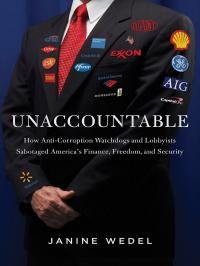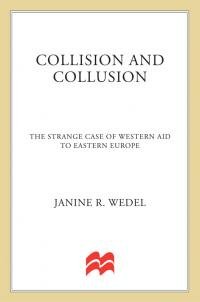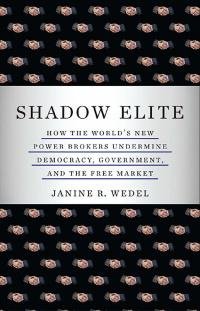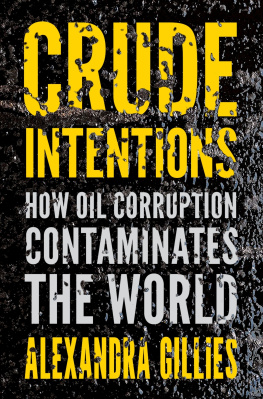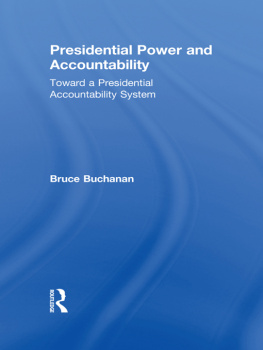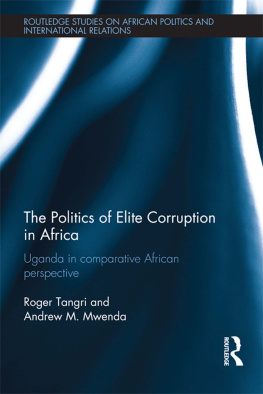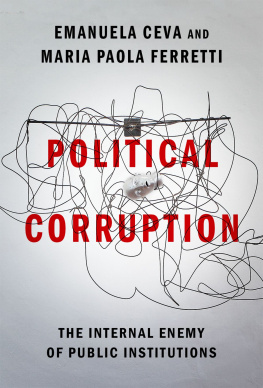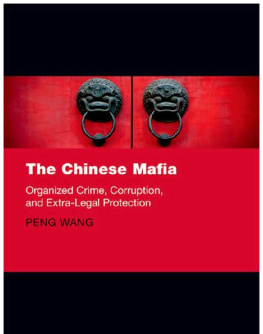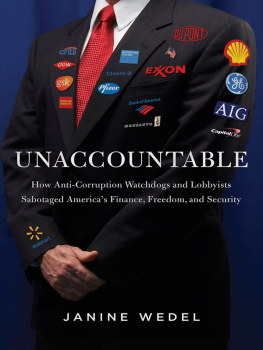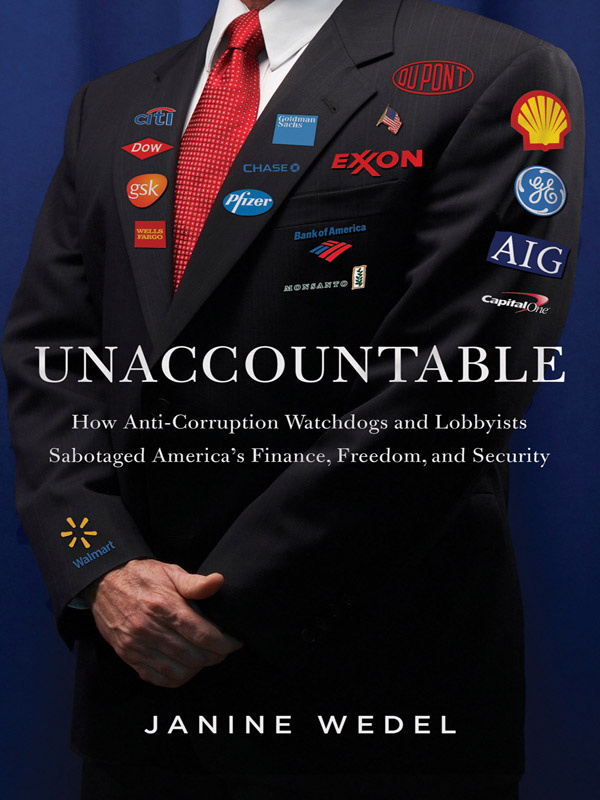
UNACCOUNTABLE
How Elite Power Brokers Corrupt Our
Finances, Freedom, and Security
JANINE R. WEDEL

Again, to my parents, Arnold and Dolores Wedel
And to the memory of Antonina Dachw and Erna P. Harris, each one a force of nature who changed my life
Contents
Preface
PART I
IN ONLY OUR OWN WE TRUST
CHAPTER 1
New World, New Corruption
CHAPTER 2
Unaccountability, Structured
CHAPTER 3
Inside the New Corruption
CHAPTER 4
High Priests and the Gospel of Anti-Corruption
CHAPTER 5
Privatizing Media, Performing Truth
PART II
THE NEW CORRUPTION AT WORK
CHAPTER 6
Spies, Company Men, and the Melded Company-State
CHAPTER 7
Thought Leaders and Think-Tankers
CHAPTER 8
Professors, Physicians, and Prestige for Hire
CHAPTER 9
Grassroots and Nonprofit Organizers
PART III
RESTORING THE PUBLIC TRUST
CHAPTER 10
What Is to Be Done?
Endnotes
Acknowledgments
Index
Preface
You might expect a book called Unaccountable to begin with tales of the wretched excesses of the one percent. Or with the in-your-face corruption of bad apples straight out of The Wolf of Wall Street.
But gaudy excess is almost by definition easily visible, unmistakable. Unfortunately, the most damaging corruption todayviolation of the public trustis not so readily seen. Nor is it uncommon or limited to isolated incidents. It is not about bad guys or aberrant, illegal behavior.
I wrote Unaccountable to bring to your attention the invisible corruption that has become business as usual when it comes to how so much power and influence work nowadays. I come to this work as a social anthropologistnot the stereotypical one who dons a pith helmet to live among a long-lost tribe in Borneo, but one who has spent her career in exotic places like Washington and Warsaw as a participant observer in think tanks, government agencies, and academic institutions. As an anthropologist who has long studied how systems and organizations actually work (as opposed to how they purport to work), it is my job to identify and explain patterns. I wrote Unaccountable to show that the modes of operating that have taken hold with this new kind of corruption have become part of our ecosystem.
These practices may look benignthey are performed by eminent and respected people who have inside information and who mostly think they are doing the right thing. They believe they have unique expertise and the personal integrity to regulate themselves and act on our behalf. But they are beyond our accountability; neither law nor ethics holds them responsible for their actions. I ask: Who does more harm to our livelihoods and security, and who helped to create more inequalities: the lone wolf like Bernie Madoff who knows hes corrupt (and eventually lands in jail), or the financial operators who, buoyed by their peers, push the limits of the law with reckless trading that brings down the economy? The players you will meet in Unaccountable, and others like them, are insidious and difficult to detect, and they do more damage than you might think. I wrote Unaccountable because, unfortunately, what you dont know and cant see can hurt you and threateneven upendyour finances, freedom, and security.
I wrote Unaccountable, too, because more and more we feel like were outsiders, excluded from a system we used to know how to negotiate but no longer quite do. Figuring things out is not as straightforward as in the past. Were subject to new ways of influencing and organizing influence that are not as obvious as they were just twenty-fiveor even fiveyears ago. Increasingly, we sense a division between outsiders and insiders and that the insiders are working on their own behalf, even as they purport to have us, the public, in mind. The rest of us are left on the outside, knocking to get in. We see bits and pieces of stories in the media, or experience them in our own communities, stories that give us pause or make us angry at being excluded. But we dont quite know what makes the system tick.
You may have heard the term shadow lobbyist floating around. Linda Keenan and I coined it several years ago in our featured column in the Huffington Post to characterize a common type of todays influencers. We offered many examples week to week. Since then, the shenanigans of shadow lobbyists have attracted increasing attention in various outlets, including the New York Times, drawing on the work of the Center for Responsive Politics, and more recently, The Nation, in a more encompassing treatment.
But while reporters and other observers are ever closer to getting the gist of the new corruption, theyre still not quite there. Their stories are mostly centered on WashingtonCapitol Hill and K Street lobbyists. Even the imagery that editors select to accompany the articles often showcases the U.S. Capitol. The medias primary targets are predictable, such as how K Street has evolved in recent years, or what former elected officials are doing. But what about former Executive Branch officials or staff? Academics? Think-tankers? The use and abuse of media?
In fact, todays most destructive corruption and unaccountability in influence-wielding are broad in scope. And they extend far beyond Washington and far beyond the United States. The new corruption I document almost certainly touches nearly everywhere.
Moreover, if we view the players being exposed as aberrations, were less inclined to look into how they operate, who and what theyre connected to, and the systemic changes that have produced them. We wont know how to spot them, what were up against, or how to effect change.
As I said, as an anthropologist it is my job to lay out the patternsto show how the pieces of the influence puzzle fit together. Its also my job as an anthropologist to point out the connections. Indeed, social-network analysischarting how people are linked to each other and to organizationsoriginates largely in social anthropology. Unaccountable connects the dotsnot just of players, their roles, affiliations, and networks. It explores relationships among systems: Cultural trends we see in media also rear their head in finance. It also ties together multiple and seemingly disconnected threads across a wide range of public and private arenas. The connections you will discern by reading Unaccountable at first may seem unrelated, but in fact they can help you make sense of the world around you.
Todays ways of influencing are not limited to one arena or another like finance, media, or politics. The lack of clear boundaries, indistinct identities, melded missions, and focus on performance that we see in the media, we also see in think tanks, academia, grassroots organizations, and government. Corporate websites now sometimes look like news outlets; news outlets products, like a collection of press releases; philanthropy, like influence-laundering. And high-powered players move agilely across arenas, say, retiring from the military and government and joining a private equity firm while assuming multiple university associations. Synthesizing a range of unfolding phenomena of global relevance, Unaccountable provides an encompassing view of modern-day influence.
Ive chosen exemplary cases that show how the mode of organizing influence has changed from the recent past and how unaccountability is thereby heightened. Every day, the media offer up more stories from which to chooseindeed, until the minute this book went to press, I was continually including new ones.
Next page
